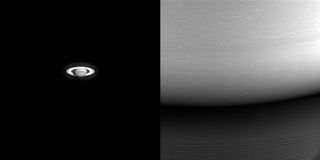Saturn Bookends: Cassini Photos Show Ringed Planet 16 Years Apart

Over the course of 16 years, Saturn went from little more than a twinkle in the Cassini spacecraft's powerful telescopic eye to the probe's final resting place.
Two newly juxtaposed images remind us of the enormity of that journey, and all the amazing things Cassini learned along the way.
Cassini captured one of the images on July 13, 2001, when the spacecraft was 317 million miles (510 million kilometers) from Saturn. The resolution is comparable to that achieved by NASA's Earth-orbiting Hubble Space Telescope, NASA officials wrote in a photo description.
The other photo was taken from a distance of 360,000 miles (579,000 km) on Sept. 14, 2017 — one day before Cassini ended its historic mission with an intentional death dive into the ringed planet's thick atmosphere. The image is one of the last that Cassini ever took, and it shows the patch of atmosphere where the probe met its fiery end, as well as some of Saturn's iconic rings, NASA officials wrote.
The $3.2 billion Cassini-Huygens mission — a joint effort of NASA, the European Space Agency and the Italian Space Agency — launched in October 1997 and arrived in the Saturn system on the night of June 30, 2004. (Huygens was a piggyback lander that touched down on Saturn's largest moon, Titan, in January 2005.)
During its 13-plus years at Saturn, Cassini discovered seas and lakes of liquid hydrocarbons on Titan — an environment that could theoretically support life. (However, any organisms on Titan's surface would have to be much different than the water-dependent life-forms of Earth.)
Cassini's observations also strongly suggest that the Saturn satellite Enceladus harbors a potentially habitable ocean of salty liquid water beneath the moon's icy crust.
Get the Space.com Newsletter
Breaking space news, the latest updates on rocket launches, skywatching events and more!
The possible habitability of Titan and Enceladus is the main reason why Cassini dove to its death in September: NASA and the probe's handlers wanted to make sure that Cassini never contaminated either moon with microbes from Earth.
Follow Mike Wall on Twitter @michaeldwall and Google+. Follow us @Spacedotcom, Facebook or Google+. Originally published on Space.com.
Join our Space Forums to keep talking space on the latest missions, night sky and more! And if you have a news tip, correction or comment, let us know at: community@space.com.

Michael Wall is a Senior Space Writer with Space.com and joined the team in 2010. He primarily covers exoplanets, spaceflight and military space, but has been known to dabble in the space art beat. His book about the search for alien life, "Out There," was published on Nov. 13, 2018. Before becoming a science writer, Michael worked as a herpetologist and wildlife biologist. He has a Ph.D. in evolutionary biology from the University of Sydney, Australia, a bachelor's degree from the University of Arizona, and a graduate certificate in science writing from the University of California, Santa Cruz. To find out what his latest project is, you can follow Michael on Twitter.
